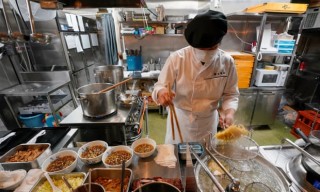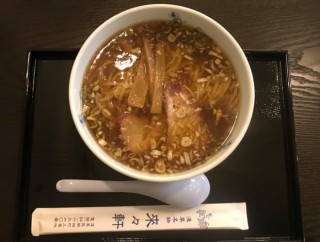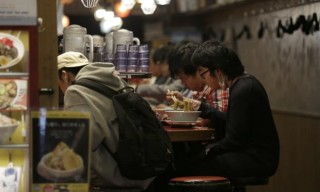Loading
Search
▼ Return Of A Ramen Pioneer Gives Boost To Japan's Covid-Hit Restaurant Sector
- Category:Other
Rai Rai Ken is back in business in Tokyo but pandemic has taken a heavy toll on ramen shops
More than a century after it welcomed its first ravenous customers in downtown Tokyo, Rai Rai Ken is back in business. On a recent afternoon, diners at its new premises in the bowels of the Shin-Yokohama Ramen Museum barely looked up as they demolished servings of noodles made according to the restaurant’s original recipe.
Rai Rai Ken is unlikely to recapture its heyday, when specially hired Chinese chefs served up to 3,000 customers a day in Tokyo’s Asakusa district. But its reappearance last month, albeit away from the cut and thrust of the high street, was a rare piece of good news for Japan’s Covid-hit restaurant sector.
Between April and September, restaurants accounted for 10% of all bankruptcies, according to Teikoku Databank. But there was worse news for purveyors of Japan’s favourite comfort food. In the nine months to the end of September, 34 ramen chains filed for bankruptcy – the first time since 2000 that bankruptcies have exceeded 30 by that point in the year. If the trend continues, 2020 could be the worst year on record for ramen shops.
The coronavirus pandemic has presented ramen restaurants with an unprecedented challenge. Many operate out of tiny premises where social distancing and profits are incompatible, with customers crammed in along narrow counters.
More than a century after it welcomed its first ravenous customers in downtown Tokyo, Rai Rai Ken is back in business. On a recent afternoon, diners at its new premises in the bowels of the Shin-Yokohama Ramen Museum barely looked up as they demolished servings of noodles made according to the restaurant’s original recipe.
Rai Rai Ken is unlikely to recapture its heyday, when specially hired Chinese chefs served up to 3,000 customers a day in Tokyo’s Asakusa district. But its reappearance last month, albeit away from the cut and thrust of the high street, was a rare piece of good news for Japan’s Covid-hit restaurant sector.
Between April and September, restaurants accounted for 10% of all bankruptcies, according to Teikoku Databank. But there was worse news for purveyors of Japan’s favourite comfort food. In the nine months to the end of September, 34 ramen chains filed for bankruptcy – the first time since 2000 that bankruptcies have exceeded 30 by that point in the year. If the trend continues, 2020 could be the worst year on record for ramen shops.
The coronavirus pandemic has presented ramen restaurants with an unprecedented challenge. Many operate out of tiny premises where social distancing and profits are incompatible, with customers crammed in along narrow counters.
Bigger chains have responded by installing plastic shields between spread-out seats, increasing delivery services and offsetting price rises by charging less during certain periods, in the hope that they can stay afloat during the pandemic.
The rest face a dilemma: ask Japan’s famously price-sensitive diners to pay more, risking driving them away, or accept the inevitable and close.
The decision is complicated by a generally accepted rule that no ramen shop hoping to retain its customers’ loyalty can charge more than ¥1,000 yen a bowl. Prices vary depending on the region, but Tokyo eateries generally charge around ¥800, while the national average is a little over ¥500, according to the ministry of internal affairs.
The pandemic has also deprived ramen shops of foreign visitors, who before the collapse of tourism would happily queue around the block to try authentic ramen at Tokyo’s better-known chains.
In fact, Covid-19 is magnifying challenges long faced by Japan’s estimated 35,000 ramen restaurants, according to Robbie Swinnerton, a food writer and restaurant reviewer for the Japan Times.
Among the wide variety of ramen devotees – from hard-up university students to mothers of young children in search of a quick lunch – the group on whom the industry depends most is office workers craving a “late-night, post-booze bowl at the train station on the way home”, says Swinnerton, who has reviewed about 30 ramen joints in Tokyo.
“With fewer people working late in the office or going out drinking – and fewer people using trains – due to Covid, this has got to be hurting the ramen trade.
But I also think tastes and demographics are changing, so there is probably less demand in general for ramen. The boom years for the ramen chains will not come back the way they were. Japan seems to be changing structurally in a way that is being accelerated by the pandemic.”
The industry is also undergoing a generational change that could hasten the demise of restaurants that opened during the era of breakneck economic growth in the 1960s and 70s and whose owners are struggling to find successors.
The effects of the pandemic aside, Kazuaki Tanaka, a ramen researcher and writer, believes the industry is settling into a state of equilibrium after years over overheating fuelled by new openings and a rash of recipe innovations ranging from seafood-based broths to tsukemen dipping noodles.
“Talk of a ramen crisis is overblown,” says Tanaka, who reckons he has eaten about 15,000 bowls of ramen in the past two decades – an average of more than 700 a year. “It’s far from being on the verge of collapse. Now that the boom has ended, the industry is maturing, and only the good places are surviving.”
There is wavering on the ¥1,000 principle as more people are willing to pay extra for “craft” ramen, inspired by growing demand for unusual or organic ingredients, and the cuisine’s entry into the gourmet fold that began in 2016 when Tsuta became the first ramen restaurant to be awarded a Michelin star.
“Younger chefs who trained under veteran cooks are opening their own places rather than taking over ageing restaurants, so the quality will keep on improving,” Tanaka says. “They trained the traditional way, but they have their own ideas.”
The rest face a dilemma: ask Japan’s famously price-sensitive diners to pay more, risking driving them away, or accept the inevitable and close.
The decision is complicated by a generally accepted rule that no ramen shop hoping to retain its customers’ loyalty can charge more than ¥1,000 yen a bowl. Prices vary depending on the region, but Tokyo eateries generally charge around ¥800, while the national average is a little over ¥500, according to the ministry of internal affairs.
The pandemic has also deprived ramen shops of foreign visitors, who before the collapse of tourism would happily queue around the block to try authentic ramen at Tokyo’s better-known chains.
In fact, Covid-19 is magnifying challenges long faced by Japan’s estimated 35,000 ramen restaurants, according to Robbie Swinnerton, a food writer and restaurant reviewer for the Japan Times.
Among the wide variety of ramen devotees – from hard-up university students to mothers of young children in search of a quick lunch – the group on whom the industry depends most is office workers craving a “late-night, post-booze bowl at the train station on the way home”, says Swinnerton, who has reviewed about 30 ramen joints in Tokyo.
“With fewer people working late in the office or going out drinking – and fewer people using trains – due to Covid, this has got to be hurting the ramen trade.
But I also think tastes and demographics are changing, so there is probably less demand in general for ramen. The boom years for the ramen chains will not come back the way they were. Japan seems to be changing structurally in a way that is being accelerated by the pandemic.”
The industry is also undergoing a generational change that could hasten the demise of restaurants that opened during the era of breakneck economic growth in the 1960s and 70s and whose owners are struggling to find successors.
The effects of the pandemic aside, Kazuaki Tanaka, a ramen researcher and writer, believes the industry is settling into a state of equilibrium after years over overheating fuelled by new openings and a rash of recipe innovations ranging from seafood-based broths to tsukemen dipping noodles.
“Talk of a ramen crisis is overblown,” says Tanaka, who reckons he has eaten about 15,000 bowls of ramen in the past two decades – an average of more than 700 a year. “It’s far from being on the verge of collapse. Now that the boom has ended, the industry is maturing, and only the good places are surviving.”
There is wavering on the ¥1,000 principle as more people are willing to pay extra for “craft” ramen, inspired by growing demand for unusual or organic ingredients, and the cuisine’s entry into the gourmet fold that began in 2016 when Tsuta became the first ramen restaurant to be awarded a Michelin star.
“Younger chefs who trained under veteran cooks are opening their own places rather than taking over ageing restaurants, so the quality will keep on improving,” Tanaka says. “They trained the traditional way, but they have their own ideas.”
Rai Rai Ken’s resurrection should serve as both a cautionary tale and cause for optimism. In 1976 it served what many thought would be its last bowl of ramen, after the then owner failed to find someone to take over the family business.
It would be another 44 years until diners were again able to sample its trademark noodles and soy-based soup coupled with char siu pork, fermented bamboo shoots and shavings of spring onion.
After several minutes of socially distanced slurping, the Guardian’s bowl of standard Rai Rai Ken ramen – priced at a little over ¥1,000 – was empty but for a couple of spoonfuls of soup. In paying gastronomic homage to its first shop, which opened in 1910, the brand’s re-emergence seems to confirm Tanaka’s buoyant prognosis for ramen’s post-Covid future.
“The secret lies is doing something different to everyone else,” he says. “It’s about the soup, the noodles, the selection of toppings, and how they all work together. If you can do that properly then people will queue up to eat your ramen. And they will keep coming back.”
It would be another 44 years until diners were again able to sample its trademark noodles and soy-based soup coupled with char siu pork, fermented bamboo shoots and shavings of spring onion.
After several minutes of socially distanced slurping, the Guardian’s bowl of standard Rai Rai Ken ramen – priced at a little over ¥1,000 – was empty but for a couple of spoonfuls of soup. In paying gastronomic homage to its first shop, which opened in 1910, the brand’s re-emergence seems to confirm Tanaka’s buoyant prognosis for ramen’s post-Covid future.
“The secret lies is doing something different to everyone else,” he says. “It’s about the soup, the noodles, the selection of toppings, and how they all work together. If you can do that properly then people will queue up to eat your ramen. And they will keep coming back.”
- November 14, 2020
- Comment (0)
- Trackback(0)




